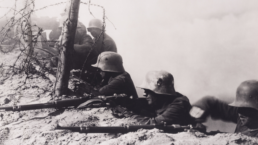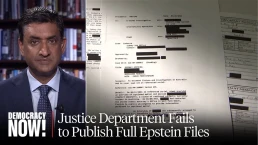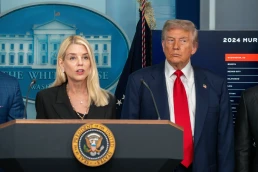The solidarity of brotherhood among troops and the pressures of nationalism made few consider opting out of a deranged war.
By Norman Solomon
Midway through his cumulatively stunning new book “Soldiers Don’t Go Mad,” author Charles Glass quotes a declaration from The Times of London on August 18, 1917: “The war has brought new opportunities of heroism to us all. Every Briton in the full strength of manhood is a soldier, and the business of fighting is his duty.”

At that point, World War One had been going on for three years, and it was to continue for another 15 months. The war killed nearly 10 million soldiers and wounded many others, while destroying the lives of uncounted civilians. All the talk about “heroism” and “duty” greased the wheels for slaughter.
Such words have an unnerving echo in our era. They sound familiar, just as the massive profiteering from “the Great War” has its counterparts in the endlessly bullish marketplace for Pentagon contracts.
By telling “A Story of Brotherhood, Poetry, and Mental Illness During the First World War” — the subtitle of his book — Glass offers an opportunity for us to compare then and now. Despite all the differences in eras, the continuities are deeply significant: starting with the reality that wars are still war and humans are still human. And, whether called shell shock or PTSD, the human consequences are evaded by top officials who order young people to kill.
Two years after war broke out in 1914, the British government set up an innovative mental institution (for “officers only”) in Scotland. Aiming to help officers who’d been traumatized in battle, Craiglockhart War Hospital treated 1,801 of them during a 30-month period. The treatment was advanced and enlightened. Yet, as Glass points out, “many of the ‘cured’ officers from Craiglockhart suffered trauma for the rest of their lives.”
The book focuses largely on Wilfred Owen and Siegfried Sassoon, two renowned poets of the First World War, who met at Craiglockhart and developed a close bond. Sassoon, a half-dozen years older than Owen, went public with his opposition to the war after experiencing its horrors in battlefields of France — yet, later on, after some recuperation, he chose to go back into combat. Owen, more reluctantly, also returned to the bloody grind of trench warfare.
Owen wrote poetry during lulls in combat. Shot dead just days before the armistice, he was 26 years old.
A famous poem by Owen ends with a Latin phrase (from the Roman poet Horace) that translates as “It is sweet and fitting to die for one’s country.” The poem concludes this way:
If in some smothering dreams, you too could pace
Behind the wagon that we flung him in,
And watch the white eyes writhing in his face,
His hanging face, like a devil’s sick of sin;
If you could hear, at every jolt, the blood
Come gargling from the froth-corrupted lungs,
Obscene as cancer, bitter as the cud
Of vile, incurable sores on innocent tongues,—
My friend, you would not tell with such high zest
To children ardent for some desperate glory,
The old Lie: Dulce et decorum est
Pro patria mori.
Yet both Owen and Sassoon were fierce and daring fighters who led men into battle, even as remorse hovered. A poem that Owen wrote in 1918, titled “Strange Meeting,” not only “revealed a poetic genius,” Glass observes, “but also guilt at killing even as he engaged it.” Owen, in command of a platoon, was determined to prove himself the epitome of courage rather than cowardice — an excellent commander and killer — yet his poetry depicted the results as hellish rather than glorious.
Such paradoxes, with fervent warriors who don’t necessarily believe in the war they’re fighting, give us a lot to think about in our own time. The disconnects between conformity and conscience might not be easy to comprehend.
As the war neared its end, Sassoon asked himself a hard question: “How could I begin my life all over again, when I had no conviction about anything except that the War was a dirty trick which has been played on me and my generation?” As Glass wrote, “The perpetual conflict between the warrior and the pacifist raged within him.”
It might seem odd that Owen and Sassoon, capable of writing such powerfully haunting poetry about the barbarism of war, would willingly return to — and strive to excel at — warfare that was steadily massacring people on a huge scale. But the solidarity of brotherhood among troops and the pressures of nationalism made few consider opting out of a deranged war. It didn’t help that, as Glass notes, 300 “shell-shocked men” were executed by the British government “for desertion or cowardice.”
The normalized baseline, from the top of the command structure, was basically insane. So, naturally, when Sassoon issued a public protest against the war, the government attributed his protest to insanity.
Technological “advances” had made it possible for governments to turn World War One into a merciless charnel house on a vast scale. Back then, the majority of war’s victims were soldiers. In the 21st century, most of war victims have been civilians.
All the changes aside, some basics are still in place. Ever since the invasions of Afghanistan in October 2001 and Iraq in March 2003, many people in the U.S. military have seen the evils of the warfare marketed under the “war on terror” slogan. But conformity has flourished in the service of the war machine. Government leaders remain masters of deception, while enormous numbers of human beings suffer the consequences.
As a journalist, Charles Glass has covered wars on the ground in the Middle East and elsewhere for several decades. His insights are subtle yet palpable in “Soldiers Don’t Go Mad,” evoking the power of war to haunt, traumatize and destroy long after the last bombs explode. Fittingly, his book’s title comes from a 1917 poem by Siegfried Sassoon — titled “Repression of War Experience” — that includes these lines: “And it’s been proved that soldiers don’t go mad / Unless they lose control of ugly thoughts / That drive them out to jabber among the trees.”
Norman Solomon is the national director of RootsAction.org and executive director of the Institute for Public Accuracy. He is the author of a dozen books including War Made Easy. His latest book, War Made Invisible: How America Hides the Human Toll of Its Military Machine, was published in June 2023 by The New Press.
Recent Posts
The “President Of Peace” Prepares For War
December 23, 2025
Take Action Now The Donroe Doctrine Hits HomeBy William D. Hartung, Tom Dispatch Earlier this month, the Trump administration released its new…
“Who Are They Protecting?”: Rep. Ro Khanna Urges Contempt Charges Over AG Bondi’s Epstein Redactions
December 22, 2025
Take Action Now “The House can act unilaterally on contempt, and this will be introduced by Thomas Massie. What the resolution will say is that…
Dems Demand Answers as Trump Photo Disappears From DOJ Online Epstein Files
December 21, 2025
Take Action Now “What else is being covered up?”By Brett Wilkins, Common Dreams Congressional Democrats on Saturday pressed US Attorney General…
Elon Musk Is Vowing Utopia Driven by AI and Robotics. Bernie Sanders Has a Few Questions
December 20, 2025
Take Action Now “I look forward to hearing about how you and your other oligarch friends are going to provide working people with a magnificent life…




